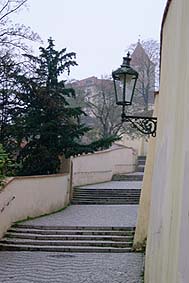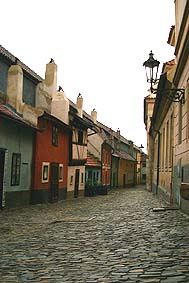|
Sitting down in the Malostranska kavarna (cafe) is a good way to get ready for your ascent to the Prague Castle. This landmark cafe was frequented by Franz Kafka when he lived in Mala Strana and wrote up at the castle. Outside its windows, past the tram tracks, is the Renaissance Mala Strana Town Hall. From the other cafe window you will see the Smiricky-Montag palace, now the administrative building of the Czech parliament. |
 |
Nerudova Street has a number of fine Baroque town houses with richly decorated facades. Makers of string instruments lived at the House of Three Little Fiddles (No.12). The Bretfeld Palace (No.33) is where Mozart and Casanova attended society balls. Where the road turns and goes directly to the castle, you will find the House of the Two Suns (No. 47), birthplace and residence of the journalist and writer Jan Neruda. Neruda's essays, poetry and short stories capture the essence of Prague, especially Mala Strana, Jewish Quarter and Old Town. How did it come about that the Chilean poet and Nobel Prize winner Pablo Neruda took his name from this Czech writer? One story is that he simply admired Jan Neruda's work. Another tells that he needed a pseudonym for his literary work, saw Neruda's name in a magazine, liked the sound of it and adopted it without reading a single line.
|
When you enter the Prague Castle through the ornate Matthias gate be prepare for an onslaught of historical facts and legends, not to mention a staggering variety of architectural styles. A short guide can barely describe what hundreds of books have mined. So first thing you do, is visit the castle information office across from St. Vitus. You can get map there, buy tickets and ask what you want to know.
The story of St. Vitus in many ways parallels the development of the whole citadel and the general course of Czech history. Built on the site of a rotunda founded in 925, it was transformed into a three aisle Romanesque basilica in 1060. In 1344, Charles IV hired Matthias of Arras to lay the foundations for the present church. Petr Parler continued the work for forty years until his death, when his sons picked up the mammoth project. Hussites severely damaged St. Vitus in 1421, however additional work was done on the church at the turn of following century. During the centuries of Habsburg rule, St. Vitus sat pretty much neglected like a dusty museum on a hill. Work picked up again in the mid 19th century, last renovations on the church facade were just completed recently. The Bohemian Crown Jewels are the most precious possession of St. Vitus and they are securely locked away in the Royal Treasury- under seven locks and keys in fact, are held by different Church and governmental institutions. The treasury is in the St. Wenceslas Chapel, a Gothic jewel placed by Petr Parler on the site of the original rotunda. Perhaps the only chapel in the cathedral which tops St. Wenceslas is four hundred feet away from the front door. An estimated two tons of silver were used to decorate the tomb of St. John of Nepomuk, at the entrance to the chapel of the same name.
Now get out of the church and cross the square, directly to the Old Royal Palace. Indoor jousting tournaments were held in the spacious Vladislav Hall (Vladislavsky sal) of the Old Royal Palace. Bohemian kings resided in the palace until 1500s. Afterward, Habsburg kings and emperors used the western wing of the castle on their visits to Prague from Vienna, the center of the empire. The palace still housed the offices of the Bohemian state until the late 1700s. The Chancellery adjoining Vladislav Hall was the site of the infamous second Prague defenestration in 1618. The imperial chancellors were thrown out the window. However, they landed in a ditch full of sewage and escaped unharmed. This was later contributed to a miracle.
|
The oldest surviving church in the castle complex is the Basilica of St. George (Bazilika sv. Jiri). Although it was rebuilt several times, recent restoration preserved many of its features from the early tenth century. The convent of St. George, founded by Prince Boleslav in 973, housed the first Bohemian monastic order.
Golden Lane (Zlata Ulicka) was a double row of decrepit wooden shacks until the reign of the Habsburg Empress Maria Theresa, who modernised much of the castle in the neo-classical style. Popular belief has it that the golden lane got its name from alchymists who worked for Rudolf II. In reality, goldsmiths set up shops here after the great fire in the Mala Strana in 1541. If you want to find out how to turn lead into gold, visit the Museum of Alchemy at the Powder Tower. Also get in the city walls and see how it looks like inside.
The Golden Lane also inspired writers, Franz Kafka rented house No.22 to work on his novel The Castle. Jaroslav Seifert, Nobel Prize winning poet also drew from the lane's genius loci. Then, in the 1960s, the houses got their pastel coats.
THIS IS THE END of one day Prague walk- now you can walk down the castle stairs to Klarov, where is the metro station A Malostranska. Don't forget to book your tickets for an evening concert
ALSO SEE:
main page of Prague2001.com
search this web site
3 days walk
some useful links
|
 |
|
